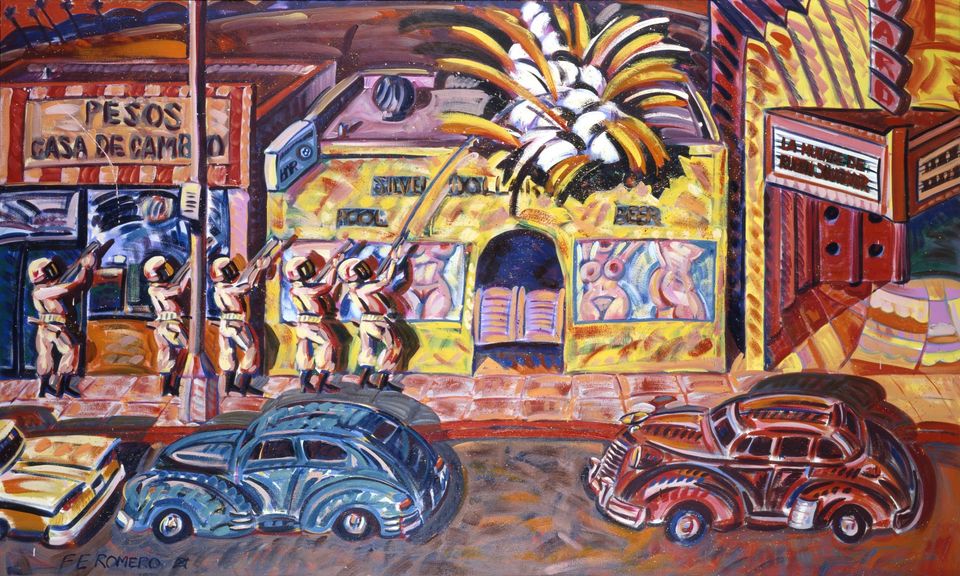
Frank Romero, Death of Rubén Salazar, 1986, oil on canvas, Smithsonian American Art Museum
About this Artwork
Romero memorializes Rubén Salazar, a Los Angeles Times journalist and key chronicler of the Chicano civil rights movement. After covering the Chicano Moratorium of 1970, an anti–Vietnam War demonstration, Salazar stopped at the Silver Dollar Café in East LA. Reports of an armed disturbance sent deputies to the scene. A tear-gas projectile shot into the bar killed Salazar instantly. Romero combined references to this tragic day with a vision of the future when Salazar is the subject of a film announced on a theater marquee. The work’s large scale and heroic subject link it with a tradition of grand painting that commemorates events that shaped history.
Acerca de esta obra
Romero rinde homenaje a la memoria de Rubén Salazar, un periodista del Los Angeles Times y uno de los principales cronistas del movimiento chicano de derechos civiles. Después de cubrir los sucesos de la Moratoria Chicana de 1970, una manifestación contra la Guerra de Vietnam, Salazar fue al Silver Dollar Café, en East Los Angeles. Información sobre un altercado armado atrajo la presencia de la policía. Un proyectil de gas lacrimógeno disparado hacia el interior del bar mató a Salazar instantáneamente. Romero combinó las referencias a este trágico día con u tema de una película anunciada en la marquesina de un teatro. El gran formato y el sujeto heroico de la obra la vinculan con la gran tradición de la pintura de historia, un género artístico que conmemora los sucesos históricos.
Video
In this series, E. Carmen Ramos, curator of Latino art, discusses the exhibition Our America: The Latino Presence in American Art at the Smithsonian American Art Museum. This episode looks at the painting Death of Rubén Salazar by Frank Romero. Our America: The Latino Presence in American Art presents the rich and varied contributions of Latino artists in the United States since the mid-twentieth century, when the concept of a collective Latino identity began to emerge. The exhibition is drawn entirely from the Smithsonian American Art Museum's pioneering collection of Latino art. It explores how Latino artists shaped the artistic movements of their day and recalibrated key themes in American art and culture.
Meet the Artist
An interview with the artist Frank Romero. Frank Romero grew up in the Hispanic, Asian, and Jewish communities of East Los Angeles. He began painting when he was five years old and as a teenager attended LA's Otis Art Institute, one of the best art schools in the nation. Romero did not think of himself as a Chicano until he began to work with three other artists in an informal group known as Los Four. Los Four and other Hispanic artists throughout the West used wall murals, graffiti, and street theater to protest America's involvement in Vietnam and Southeast Asia. The police response to antiwar demonstrations in Los Angeles was part of a larger pattern of violence against the minority communities that Romero experienced throughout his life. It takes years for the artist to think through and to paint these episodes in the life of his community, because, he says, "That stuff is hard for me to do, it hurts, it's frightening" (Los Angeles Times, July 28, 2002 [online]). Romero's brightly colored paintings celebrate the Los Angeles culture of lowriders and "rascuache," the art of making something beautiful out of the ordinary.













